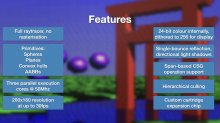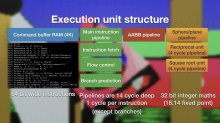Developer shows off SNES raytracing through the custom-made SuperRT chip
RTX off, RTX on! RTX on...the SNES! Developer Shironeko Labs, otherwise known as Ben Carter, has been playing around with a project idea for around a year: getting real-time raytracing to work on the Super Nintendo of all things. The culmination of his work has resulted in the SuperRT, an expansion chip, similar in function to the Super FX chip. This additional cartridge, which was made from the combination of a Super Famicom Pachinko game, a ton of cables, a shifter board, and a Cyclone V FPGA allows for the Super Nintendo to render simple objects, shadows, and reflections, in full ray-traced glory, all at a glorious resolution of 200x160.
The SuperRT chip constructs the scene using a specialised command language which is executed by one of three parallel execution units on the chip - essentially specialised CISC processors - to perform ray intersection tests. The scene description allows objects to be constructed using a subset of CSG operations, using spheres and planes as the basic building blocks and then performing OR, AND and subtraction operations using them to build up the desired geometry. AABBs are also supported, although primarily for use in culling tests (they can be rendered if desired, but they have a lower positional accuracy than other primitives and thus this is not generally very useful except for debugging purposes).
Carter goes into full detail on his official website about how he got his demo to work, which involved lots of commands, conversions, and many other technical terms.
The chip also implements a number of other basic functions - there is an interface to the SNES cartridge bus, along with a small program ROM holding 32K of code for the SNES (this is constrained by the fact that the interface board currently only connects up the SNES Address Bus A lines, and thus the effective usable address space is a mere 64K, of which 32K is used for memory-mapped IO registers to communicate with the SuperRT chip). There is also a multiplication accelerator unit that lets the SNES perform 16x16bit multiply operations rapidly.



 Thank you GBAtemp for these things.
Thank you GBAtemp for these things.







